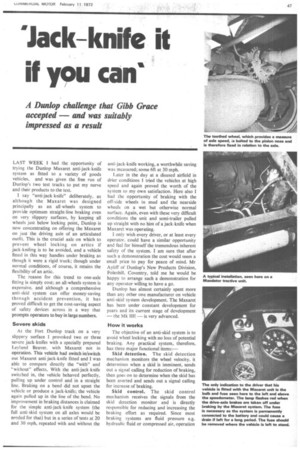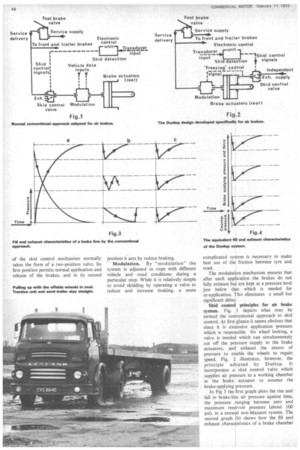'Jack knife if y9u Can'
Page 49

Page 50

Page 51

If you've noticed an error in this article please click here to report it so we can fix it.
A Dunlop challenge that Gibb Grace accepted — and was suitably impressed as a result
LAST WEEK I had the opportunity of trying the Dunlop Maxaret anti-jack-knife system as fitted to a variety of goods vehicles, and was given the free run of Dunlop's two test tracks to put my nerve and their products to the test.
I say "anti-jack-knife" deliberately, as although the Maxaret was designed principally as an all-wheels system to provide optimum straight-line braking even on very slippery surfaces, by keeping all wheels just below locking point, Dunlop is now concentrating on offering the Maxaret on just the driving axle of an articulated outfit. This is the crucial axle on which to prevent wheel locking on artics if jack-knifing is to be avoided, and a vehicle fitted in this way handles under braking as though it were a rigid truck; though under normal conditions, of course, it retains the flexibility of an artic.
The reason for this trend to one-axle fitting is simply cost; an all-wheels system is expensive, and although a comprehensive anti-skid system can offer money-saving through accident prevention, it has proved difficult to get the cost-saving aspect of safety devices across in a way that prompts operators to buy in large numbers.
Severe skids
At the Fort Dunlop track on a very slippery surface I provoked two or three severe jack-knifes with a specially prepared Leyland Beaver, with Maxaret not in operation. This vehicle had switch in/switch out Maxaret anti-jack-knife fitted and I was able to compare directly the "with" and "without" effects, With the anti-jack-knife switched in, the vehicle behaved perfectly, pulling up under control and in a straight line. Braking on a bend did not upset the vehicle or produce a jack-knife; the vehicle again pulled up in the line of the .bend. No improvement in braking distances is claimed for the simple anti-jack-knife system (the full anti-skid system on all axles would be needed for that) but in a series of tests at 20 and 30 mph, repeated with and without the
anti-jack-knife working, a worthwhile saving was measured; some 6ft at 30 mph.
Later in the day at a disused airfield in drier conditions I tried the vehicles at high speed and again proved the worth of the system to my own satisfaction. Here also I had the opportunity of braking with the off-side wheels in mud and the nearside wheels on a wet but otherwise normal surface. Again, even with these very difficult conditions the unit and semi-trailer pulled up straight with no hint of a jack-knife when Maxaret was operating.
I only wish every driver, or at least every operator. could have a similar opportunity and fed for himself the tremendous inherent safety of the system. I am sure that after such a demonstration the cost would seem a small price to pay for peace of mind. Mr Ayliff of Dunlop's New Products Division, Foleshill, Coventry, told me he would be happy to arrange such a demonstration for any operator willing to have a go.
Dunlop has almost certainly spent more than any other one manufacturer on vehicle anti-skid system development. The Maxaret has been under constant development for years and its current stage of development — the Mk IIE — is very advanced.
How it works
The objective of an anti-skid system is to avoid wheel locking with no loss of potential braking. Any practical system, therefore, has three major functional items:— Skid detection. The skid detection mechanism monitors the wheel velocity, it determines when a skid is imminent, sends out a signal calling for reduction of braking, then goes on to determine when the skid has been averted and sends out a signal calling for increase of braking.
Skid control. The skid control mechanism receives the signals from the skid detection monitor and is directly responsible for reducing and increasing the braking effort as required. Since most braking systems are fluid pressure e.g. hydraulic fluid or compressed air, operation of the skid control mechanism normally takes the form of a two-position valve. Its first position permits normal application and release of the brakes, and in its second
Pulling up with the offside wheels in mud. Tractive unit and semi-trailer stay straight.
position it acts by reduce braking.
Modulation. By "modulation" the system is adjusted to cope with different vehicle and road conditions during a particular stop. While it is relatively simple to avoid skidding by operating a valve to reduce and increase braking, a more
complicated system is necessary to make best use of the friction between tyre and road.
The modulation mechanism ensures that after each application the brakes do not fully exhaust but are kept at a pressure level just below that which is needed for re-application. This eliminates a small but significant delay.
Skid control principles for air brake system. Fig. 1 depicts what may be termed the conventional approach to skid control. At first glance it seems obvious that since it is excessive application pressure which is responsible for wheel locking, a valve is needed which can simultaneously cut off the pressure supply to the brake actuators, and exhaust the excess of pressure to enable the wheels to regain speed. Fig. 2 illustrates, however, the principle adopted by Dunlop. It incorporates a skid control valve which supplies air pressure to a working chamber in the brake actuator to counter the brake-applying pressure.
In Fig 3 the first graph plots the rise and fall in brake-line air pressure against time, the pressure ranging between zero and maximum reservoir pressure (about 100 psi), in a normal non-Maxaret system. The second graph (b) shows how the fill and exhaust characteristics of a brake chamber
diaphragm vary according to the level of applied pressure. Ideally. these characteristics should remain constant regardless of pressure, and this can be done by "modulation" of a conventional system, as revealed at (c). This is the form required for anti-skid results.
Fig 4 shows how Maxaret, by using a pressure (counter-pressure) directed in the opposite sense to the applying pressure, achieves the desired characteristics regardless of the brake-applying pressure level. It shows how the cycle of brake release and re-application stays constant.
Dunlop chose the principle illustrated in Fig 2 as being most suitable for a reliable, simple. reproducable and basically safe system which is tolerant of poor vehicle maintenance that is, compared with aircraft, for which the Maxaret was originally developed.
While this design does require a brake actuator with an extra working chamber the functional advantages derived make this well worth while.
To consider the features mentioned one at a time:
Reliability. Electronic skid detection is used because it is best able to withstand the rugged operating conditions typical of commercial vehicles. For example, the electromagnetic transducer which measures rdad-wheel speed is mounted remotely from the prop-shaft and so has no rubbing parts. The system is not affected by road dirt, water, salt, etc. The signals it puts out are fed to an electronic control unit which is completely encapsulated in plastic and is therefore protected against shock, vibration and corrosion, the circuit design is such that it will operate satisfactorily down to 25 per cent less than nominal battery voltage. This adequately caters for cold weather, heavy starter drain, conditions.
Simplicity. All the control calculations for Maxaret are performed by the electronic unit which is a service replacement part. The pneumatic units are all simple "go /no-go" devices. The design of the system enables natural air-flow laws to be used to advantage. Fig. 3 graphically illustrates the problems of modulation which Dunlop has avoided by their "counter-pressure" solution seen in Fig. 4.
Reproductive capacity. The system can be reproduced on any number of vehicles of a given type. It is only necessary to arrange the number of teeth on the propeller-shaft sensing disc to suit the particular rear axle ratio, and to set the Maxaret to the right air-flow rate for a particular vehicle's brake system.
Tolerance of poor vehicle maintenance conditions. The conventional approach is dependent upon well maintained brake operating linkages, because it reduces brake applying pressure to correct skidding and hence free return of the brake operating mechanism is essential.
The counter-pressure feature of the Dunlop design will effectively, overcome considerable brake linkage stiffness. This is an important factor on winter roads. Under these conditions skid control is most necessary and corrosion of operating mechanisms is likely to be at its worst.








































































































